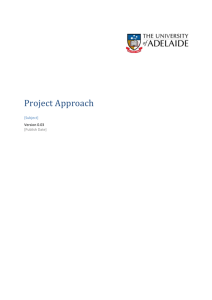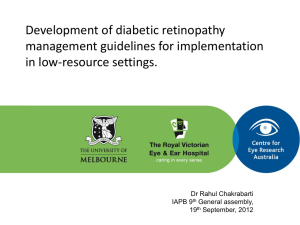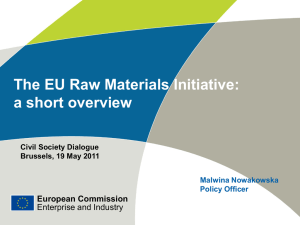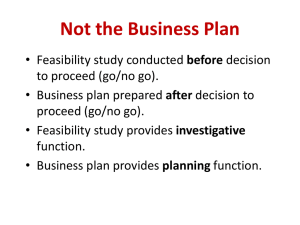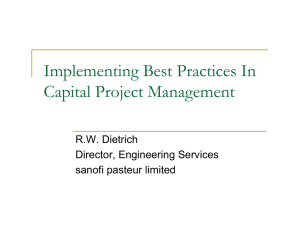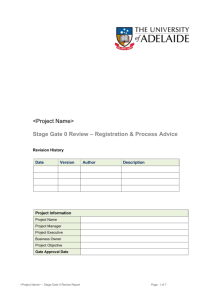Options Analysis - University of Adelaide
advertisement
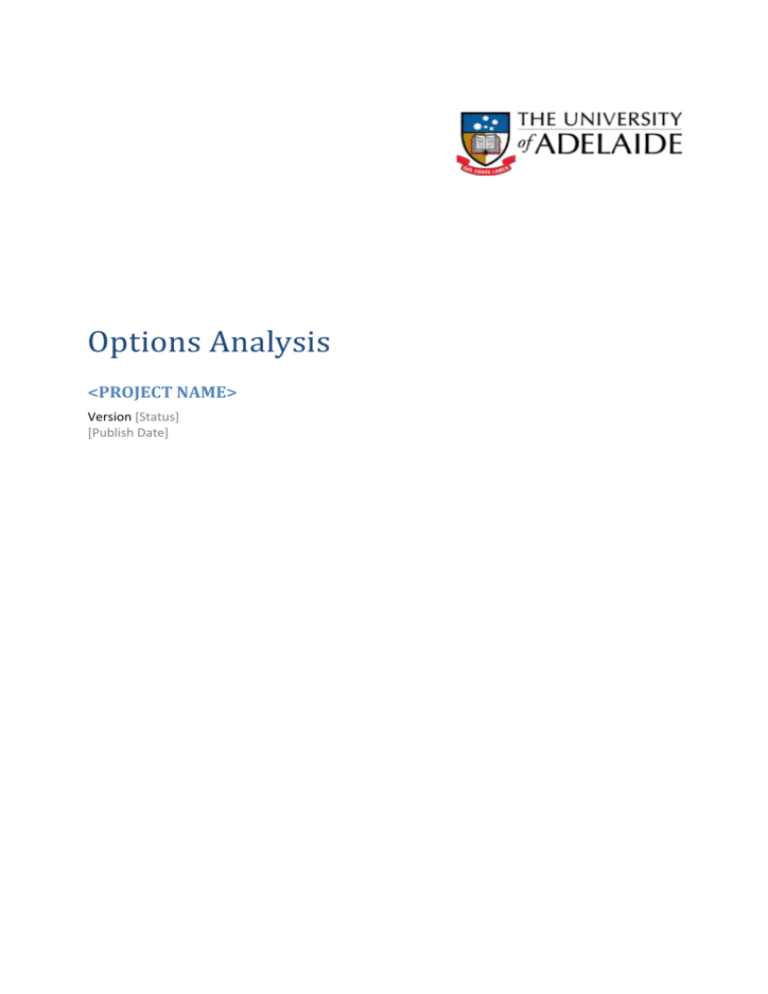
Options Analysis <PROJECT NAME> Version [Status] [Publish Date] Options Analysis <project name> REVISION HISTORY Date [Publish Date] Version Description of Change/Revision Author [Status] APPROVALS Group / Committee Name Members Date of Issue Version DISTRIBUTION Role Version Print Name Date of Issue Page 2 of 15 Options Analysis <project name> TABLE OF CONTENTS 1 Document Overview .......................................................................................................................... 4 1.1 Context.................................................................................................................................. 4 1.2 Purpose ................................................................................................................................. 5 2 The Case for Change .......................................................................................................................... 6 2.1 Background ........................................................................................................................... 6 2.2 Current State......................................................................................................................... 6 2.3 Envisioned Future State ........................................................................................................ 6 3 Project Overview ............................................................................................................................... 7 3.1 Scope..................................................................................................................................... 7 3.2 Approach ............................................................................................................................... 7 3.3 Timeline ................................................................................................................................ 7 3.4 Assumptions.......................................................................................................................... 7 3.5 Constraints ............................................................................................................................ 7 4 Analysis Approach.............................................................................................................................. 9 4.1 Solution Identification .......................................................................................................... 9 4.2 Solution Qualification ........................................................................................................... 9 4.3 Solution Evaluation ............................................................................................................... 9 5 Solution Qualification ...................................................................................................................... 10 6 Solution Evaluation .......................................................................................................................... 11 6.1 Solution 1 - <Name> ........................................................................................................... 11 6.1.1 Outline ................................................................................................................................ 11 6.1.2 Evaluation ........................................................................................................................... 11 6.2 Solution 2 - <Name> ........................................................................................................... 11 6.2.1 Outline ................................................................................................................................ 11 6.2.2 Evaluation ........................................................................................................................... 11 7 Analysis and Recommendation ....................................................................................................... 12 7.1 Comparative Analysis and Ranking ..................................................................................... 12 7.2 Recommended Option Selection ........................................................................................ 12 8 Glossary ........................................................................................................................................... 13 9 References ....................................................................................................................................... 14 Appendix A: Version Risk Rating Determination Matrix ................................................................................... 15 Page 3 of 15 Options Analysis <project name> 1 DOCUMENT OVERVIEW 1.1 Context IT projects that deliver enterprise support for the University of Adelaide are managed in accordance with the Project Management Framework. The primary goals of this framework are: To improve the delivery performance of IT projects by applying a consistent approach, sharing best practices, and enabling continuous process improvement. To ensure that the University can exercise an appropriate level of control and oversight over IT projects from a strategic, financial, technical, and management perspective. For more information on the Project Management Framework, please refer to: https://www.adelaide.edu.au/infrastructure/solution_delivery/framework/lifecycle/. This Solution Architecture has been produced in the Feasibility phase of the Project Management Framework as shown in the following figure. Concept Feasibility Delivery Detailed Design/ Planning Build/ Configure and Test Implement Close Out/ Operational Gate 0 Gate 1 Gate 2 Gate 3 Gate 4 Gate 5 Registration and Process Advice Feasibility Assessment Delivery Readiness Assessment Transition Readiness Assessment Operational Readiness Assessment Benefits Realisation & Close Out Figure 1: Feasibility phase highlighted in the Project Management Framework The primary objective of the Feasibility phase of the project is to produce a reliable statement of agreement between the stakeholder group and the delivery group in terms of investment versus outcome – in other words, an approved business case. It achieves this by: Defining the business and IT system requirements The business requirements are defined in terms of organisational context, user roles, business processes, business information, business rules, and business operations. Through analysis of existing IT systems, manual vs. automated processes, the conceptual IT system is scoped and defined in terms of functional and non-functional requirements. Evaluating IT options and defining the recommended solution Where the IT solution is not defined in the Concept phase, IT system requirements are used to seek and evaluate IT solution alternatives. Mechanisms such EOI (expression of interest), RFI (request for information), or RFT (request for tender) may be used for engaging with the market, and numerically-based scoring methods for comparative evaluation. The recommended option is endorsed by all relevant stakeholders prior to its more detailed solution architecture definition for the purpose of project planning and estimating. Planning and estimating Based on the recommended solution architecture, the business case is developed to bring together Version Page 4 of 15 Options Analysis <project name> the proposed outcome (scope, new capabilities, business benefits, business change, etc.) with the required investment (capital costs, resources, time, operating costs, etc.). These elements are depicted in the following figure with this document highlighted. Feasibility Requirements Options and Architecture Business Specification Options Analysis IT System Specification Solution Architecture Planning and Estimation Business Case Gate 1 Feasibility Assessment Figure 2: Options Analysis document highlighted in the context of the Feasibility phase 1.2 Purpose The purpose of this document is to: Define the approach used to identify, qualify, and evaluate solution options to enable suitable candidates to be ranked for selection. Define the available solutions identified (the “long list”) and document the outcome of the qualification assessment (to produce the “short list”). Provide an outline of each qualified solution and document the outcome its evaluation. Provide a ranking of solutions and act as the primary vehicle to engage with stakeholders to obtain approval for option selection. Version Page 5 of 15 Options Analysis <project name> 2 THE CASE FOR CHANGE 2.1 Background Background and context to the project. 2.2 Current State “Where are we now…” – provide a very brief overview of the current situation giving rise to the need for a solution. 2.3 Envisioned Future State “Where do we want to be...” – provide a very brief overview of the future state after the solution has been delivered. Version Page 6 of 15 Options Analysis <project name> 3 PROJECT OVERVIEW 3.1 Scope The following tables define the project scope inclusions and exclusions respectively. Table 1: Project scope inclusions ID Scope Inclusion SI001 SI002 SI003 Table 2: Project scope exclusions ID Scope Exclusion SE001 SE002 SE003 3.2 Approach 3.3 Timeline 3.4 Assumptions The assumptions in the following table are known facts that have the effect of enabling, supporting, or justifying specific aspects of the project. Table 3: Project assumptions ID Project Assumption PA001 PA002 PA003 3.5 Constraints The constraints in the following table are known facts that have the effect of impacting or limiting the project. Version Page 7 of 15 Options Analysis <project name> Table 4: Project constraints ID Project Constraint PC001 PC002 PC003 Version Page 8 of 15 Options Analysis <project name> 4 ANALYSIS APPROACH 4.1 Solution Identification 4.2 Solution Qualification 4.3 Solution Evaluation Version Page 9 of 15 Options Analysis <project name> 5 SOLUTION QUALIFICATION Version Page 10 of 15 Options Analysis <project name> 6 SOLUTION EVALUATION 6.1 Solution 1 - <Name> 6.1.1 Outline 6.1.2 Evaluation 6.2 Solution 2 - <Name> Version 6.2.1 Outline 6.2.2 Evaluation Page 11 of 15 Options Analysis <project name> 7 ANALYSIS AND RECOMMENDATION 7.1 Comparative Analysis and Ranking 7.2 Recommended Option Selection Version Page 12 of 15 Options Analysis <project name> 8 GLOSSARY The following table provides a brief definition of the terms and acronyms used in this document. Table 5: Definition of terms and acronyms Term/Acronym Definition TCO Total Cost of Ownership – the total cost of a solution over a prescribed number of years including both the implementation project costs as well as the net change in annual operating costs. PMF Project Management Framework – the defined approach to IT project delivery used by the University of Adelaide. Version Page 13 of 15 Options Analysis <project name> 9 REFERENCES The following references were cited in this document:There are no sources in the current document. Version Page 14 of 15 Options Analysis <project name> APPENDIX A: RISK RATING DETERMINATION MATRIX Risks are rated as ‘High’, ‘Medium’, or ‘Low’ based on likelihood and impact in accordance with the following matrix. Impact Low Medium High Low Low Low Medium Medium Low Medium High High Medium High Extreme Likelihood Risk Rating Figure 3: Risk rating determination matrix Version Page 15 of 15
